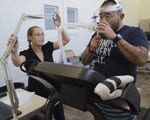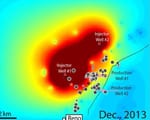Defense Advanced Research Projects Agency seeks technology for soldiers to “see” around corners, behind walls

Researchers from SMU’s Lyle School of Engineering will lead a multi-university team funded by the Defense Advanced Research Projects Agency (DARPA) to build a theoretical framework for creating a computer-generated image of an object hidden from sight around a corner or behind a wall.
The core of the proposal is to develop a computer algorithm to unscramble the light that bounces off irregular surfaces to create a holographic image of hidden objects.
“This will allow us to build a 3-D representation – a hologram – of something that is out of view,” said Marc Christensen, dean of the Bobby B. Lyle School of Engineering at SMU and principal investigator for the project.
“Your eyes can’t do that,” Christensen said. “It doesn’t mean we can’t do that.”
The DARPA award is for a four-year project with anticipated total funding of $4.87 million. SMU Lyle has been awarded $2.2 million for the first two years of what DARPA calls the “REVEAL” project, with the expectation that phase II funding of another $2.67 million will awarded by 2018. SMU is the lead university for the research and is collaborating with engineers from Rice, Northwestern, and Harvard.
Co-investigators for the SMU team are Duncan MacFarlane, Bobby B. Lyle Centennial Chair in Engineering Entrepreneurship and professor of electrical engineering; and Prasanna Rangarajan, a research assistant professor who directs the Lyle School’s Photonics Architecture Lab.
DARPA’s mission, which dates back to reaction against the Soviet Union’s launch of SPUTNIK in 1957, is to make pivotal investments in breakthrough technologies for national security.
In seeking proposals for its “REVEAL” program, DARPA officials noted that conventional optical imaging systems today largely limit themselves to the measurement of light intensity, providing two-dimensional renderings of three-dimensional scenes and ignoring significant amounts of additional information that may be carried by captured light. SMU’s Christensen, an expert in photonics, explains the challenge like this:
“Light bounces off the smooth surface of a mirror at the same angle at which it hits the mirror, which is what allows the human eye to “see” a recognizable image of the event – a reflection,” Christensen said. “But light bouncing off the irregular surface of a wall or other non–reflective surface is scattered, which the human eye cannot image into anything intelligible.
“So the question becomes whether a computer can manipulate and process the light reflecting off a wall – unscrambling it to form a recognizable image – like light reflecting off a mirror,” Christensen explained. “Can a computer interpret the light bouncing around in ways that our eyes cannot?”
In an effort to tackle the problem, the proposed research effort will extend the light transport models currently employed in the computer graphics and vision communities based on radiance propagation to simultaneously accommodate the finite speed of light and the wave nature of light. For example, light travels at different speeds through different media (air, water, glass, etc.) and light waves within the visible spectrum scatter at different rates depending on color.
The Goal for the DARPA program is to develop a fundamental science for indirect imaging in scattering environments. This will lead to systems which can “see” around corners and behind obstructions at distances ranging from meters to kilometers.
People have been using imaging systems to gain knowledge of distant or microscopic objects for centuries, Christensen notes. But the last decade has witnessed a number of advancements that prepare engineers for the revolution that DARPA is seeking.
“For example, the speed and sophistication of signal processing (the process of converting analog transmissions into digital signals) has reached the point where we can accomplish really intensive computational tasks on handheld devices,” Christensen said. “What that means is that whatever solutions we design should be easily transportable into the battlefield.”
The SMU-led DARPA project is working under the acronym OMNISCIENT – “Obtaining Multipath & Non-line-of-sight Information by Sensing Coherence & Intensity with Emerging Novel Techniques.”
The team unites leading researchers in the fields of computational imaging, computer vision, signal processing, information theory and computer graphics. Guiding the Rice University component of the research are Ashok Veeraraghavan, assistant professor of electrical and computer engineering, and Richard Baraniuk, Victor E, Cameron Professor; leading the Northwestern component is Oliver Cossairt, assistant professor of electrical engineering and computer science and head of the university’s Computational Photography Lab; and the Harvard research is led by Todd Zickler, professor of electrical engineering and computer science. Wolfgang Heindcrich, director of the Visual Computing Center at King Abdullah University of Science and Technology, will be a consultant to the SMU Team.
— Kim Cobb
SMU is a nationally ranked private university in Dallas founded 100 years ago. Today, SMU enrolls nearly 11,000 students who benefit from the academic opportunities and international reach of seven degree-granting schools. For more information see www.smu.edu.
SMU has an uplink facility located on campus for live TV, radio, or online interviews. To speak with an SMU expert or book an SMU guest in the studio, call SMU News & Communications at 214-768-7650.[/fusion_builder_column][/fusion_builder_row][/fusion_builder_container]

 NASA data leads to rare discovery: Earth’s moon wandered off axis billions of years ago
NASA data leads to rare discovery: Earth’s moon wandered off axis billions of years ago Good news! You’re likely burning more calories than you thought
Good news! You’re likely burning more calories than you thought New look at Pizarro’s conquest of Inca reveals foot soldiers were awed by empire’s grandeur
New look at Pizarro’s conquest of Inca reveals foot soldiers were awed by empire’s grandeur Charity, social justice and earth-friendly activism replace big houses, diamond rings and ostentatious living for status seekers
Charity, social justice and earth-friendly activism replace big houses, diamond rings and ostentatious living for status seekers National Center for Arts Research white paper counters findings of the Devos Institute Study on Culturally Specific Arts Organizations
National Center for Arts Research white paper counters findings of the Devos Institute Study on Culturally Specific Arts Organizations Long-term daily contact with Spanish missions triggered collapse of Native American populations in New Mexico
Long-term daily contact with Spanish missions triggered collapse of Native American populations in New Mexico North America’s newest pterosaur is a Texan — and flying reptile’s closest cousin is English
North America’s newest pterosaur is a Texan — and flying reptile’s closest cousin is English California 6th grade science books: Climate change a matter of opinion not scientific fact
California 6th grade science books: Climate change a matter of opinion not scientific fact

 Top Quark: New precise particle measurement improves subatomic tool for probing mysteries of universe
Top Quark: New precise particle measurement improves subatomic tool for probing mysteries of universe New fossils intensify mystery of short-lived, toothy mammals unique to ancient North Pacific
New fossils intensify mystery of short-lived, toothy mammals unique to ancient North Pacific Drugs behave as predicted in computer model of key protein, enabling cancer drug discovery
Drugs behave as predicted in computer model of key protein, enabling cancer drug discovery Researchers discover new drug-like compounds that may improve odds for men battling prostate cancer
Researchers discover new drug-like compounds that may improve odds for men battling prostate cancer Fermilab experiment observes change in neutrinos from one type to another over 500 miles
Fermilab experiment observes change in neutrinos from one type to another over 500 miles Large genome-scale study finds Native American ancestors arrived in single migration wave
Large genome-scale study finds Native American ancestors arrived in single migration wave $3.78 million awarded by Department of Defense to SMU STEM project for minority students
$3.78 million awarded by Department of Defense to SMU STEM project for minority students Kennewick Man: genome sequence of 8,500-year-old skeleton solves scientific controversy
Kennewick Man: genome sequence of 8,500-year-old skeleton solves scientific controversy At peak fertility, women who desire to maintain body attractiveness report they eat less
At peak fertility, women who desire to maintain body attractiveness report they eat less SMU seismology team to cooperate with state, federal scientists in study of May 7 Venus, Texas earthquake
SMU seismology team to cooperate with state, federal scientists in study of May 7 Venus, Texas earthquake 1st proton collisions at the world’s largest science experiment expected to start the first or second week of June
1st proton collisions at the world’s largest science experiment expected to start the first or second week of June Most likely cause of 2013-14 earthquakes: Combination of gas field fluid injection, removal
Most likely cause of 2013-14 earthquakes: Combination of gas field fluid injection, removal


